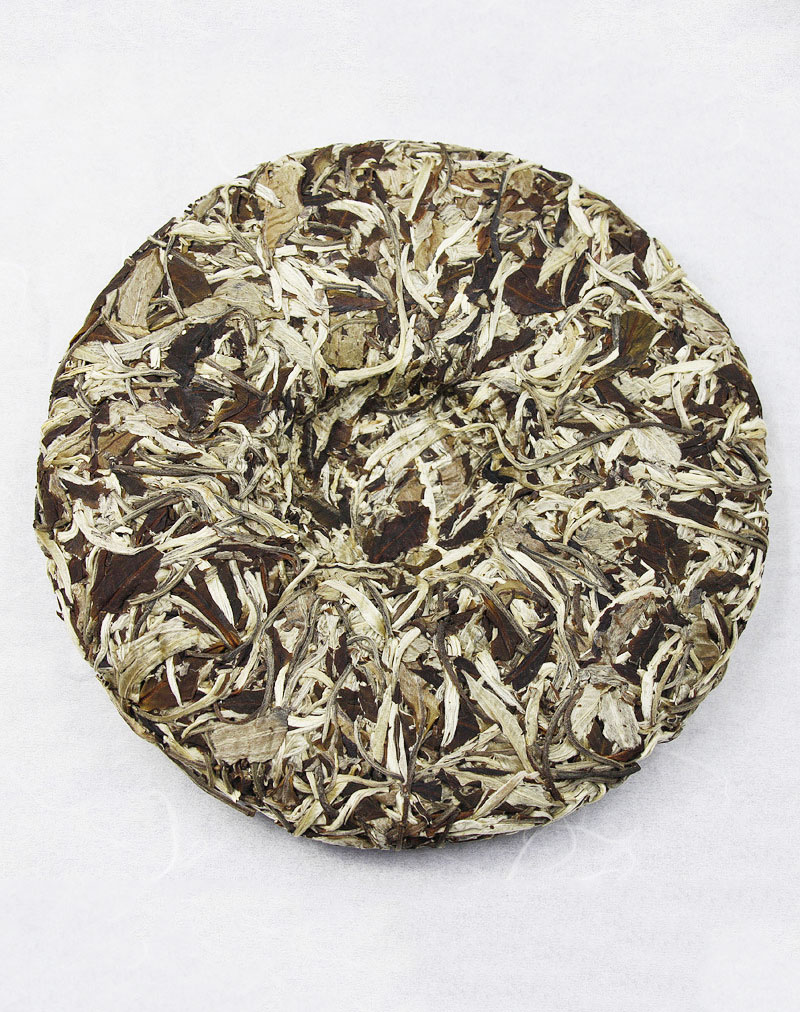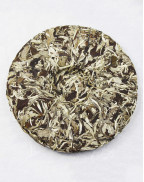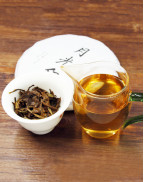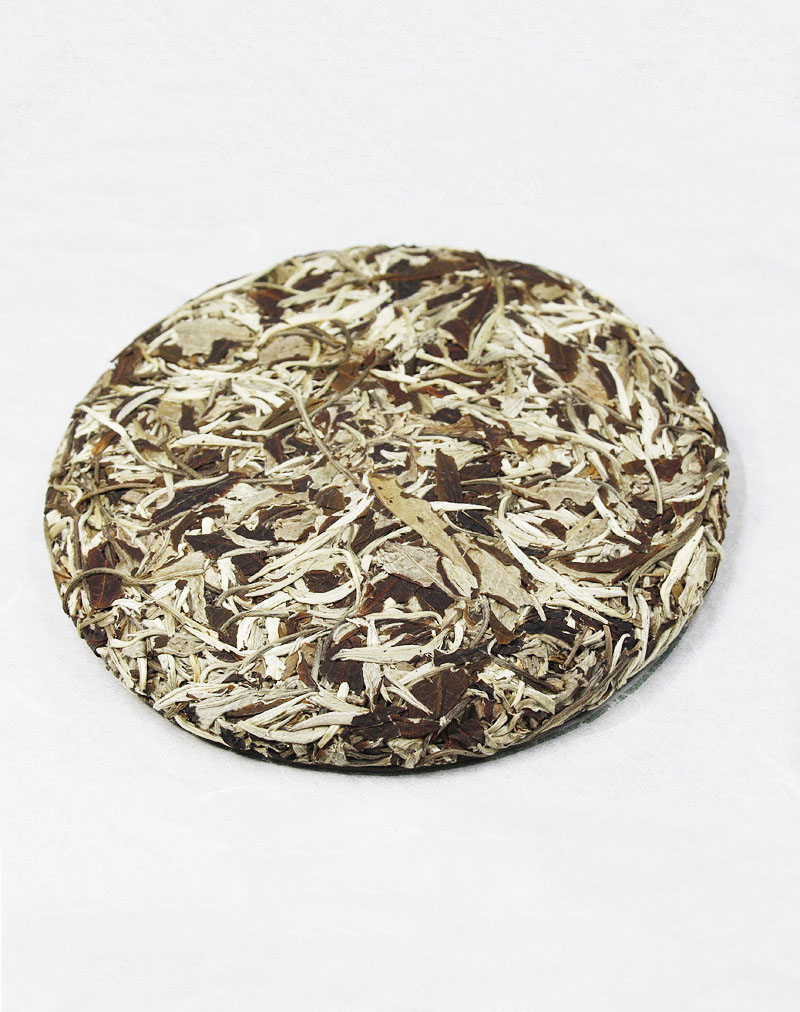Moonlight White (Yue Guang Bai) Tea Cake
- Product Code: simple
- Availability: In Stock
Basic Info
Name: Moonlight White Tea Cake
Other Names: Moonlight Bai Cha (Yue Guang Bai /月光白)
Category: Yunnan White tea
Origin: Jinggu, Yunnan, China
Tea Bush Yunnan Jinggu Da Bai Cha
Taste & Aroma: Mellow, full-bodied, herbals note, soft,floral,a lingering sweetness
Tea Garden: Da Dingguang tea garden
Liquor: Yellowish,clear and bright
Harvest Period: Spring 2024
Altitude: 1600M above sea level
Fermentation: Light
Season: Spring tea
Age of Tea Trees: 100 years+
Item Form: Tea cake
Ingredients:100% hand-picked natural tea buds and leaves
Tea Maker: Wang lin
Shelf Life: 3-7 years at room temperature
Storage: Stored in cool, airtight, opaque containers
Flavor: Unflavored
Caffeine: Low
Moonlight White (Yue Guang Bai) Tea Cake
Indulge in the exquisite allure of Moonlight White Tea, a captivating blend that seamlessly merges tradition and innovation. Crafted from the pristine leaves of Yunnan Jinggu Da Bai Cha using time-honored white tea production techniques, Moonlight White Tea presents a visual symphony with black leaves on the surface and white underneath, reminiscent of a crescent moon in the night sky. This unique tea, also known as Moonlight Bai Cha, boasts an infusion of orange-yellow brilliance, offering a taste that is not only mellow and full-bodied but also graced with a delightful sweetness that lingers. The artful compression of Moonlight White Tea into cakes preserves its nutritional essence, making it a treasure to behold and a pleasure to savor.
Sidenote: It is suitable to use the cold brewing method for this tea. Cold brewing, which involves steeping tea leaves in cold water, is becoming increasingly popular, especially during hot summers when people crave a refreshing drink. Cold brewing tea is very simple - just place the tea leaves in mineral water and store the bottle in the refrigerator. After a short wait of several tens of minutes or even a few hours, the tea is ready to be enjoyed. Although cold brewing doesn't release the aroma as quickly as hot brewing, it allows the tea to gradually infuse and develop a rich flavor. The tea leaves slowly release their aroma, creating a gentle and harmonious taste.
Basic Information
Moonlight White Tea, also known as Moonlight Bai Cha (Yue Guang Bai /月光白), belongs to the category of white tea. It is a type of white tea made using Yunnan Jinggu Da Bai Cha as the primary raw material through traditional white tea production techniques. The leaves of Moonlight White Tea are black on the surface and white on the back (alternating black and white), with visible buds, bright white curves, and a bright orange-yellow infusion. The taste is mellow, thick, and leaves a sweet aftertaste. Compressing Moonlight White Tea into cakes maximizes the retention of the tea's nutritional components, preventing loss during transportation and storage. Over time, the tea polyphenols and amino acids in the leaves undergo continuous transformation, enhancing the flavor.
Origin of the Name
The name "Moonlight White" comes from the tea's production method and the color of the dry tea leaves. The leaves are black on the surface, white on the back (with visible white buds), creating a pattern resembling a crescent moon. The tea is named "Moonlight White" because it looks like the moon in the night sky. Additionally, the tea is processed at night, away from sunlight, and slowly air-dried under moonlight, giving it the name "Moonlight White." The tea's gentle taste, sweetness, and lingering aftertaste align with the Daoist concept of "Yin and Soft," leading to its alternative name, "太乙茶Taiyi Tea." Also, since the tea is harvested and processed by young girls, it is known as "Moonlight Beauty."

A Topographic Map Of Yunnan
Show Full Description
Harvesting and Production Process
The harvesting of Moonlight White Tea leaves is meticulous, focusing on picking one bud and one or two leaves near the bud. After harvesting, the leaves are spread out on sifts, placed on wooden racks indoors to avoid direct sunlight. This allows the leaves to naturally wither, dehydrate, and undergo mild fermentation during the withering process without rolling. Traditional white tea often employs sunlight withering, but Moonlight White Tea requires shade drying, either in moonlight or a dark place.
Origin
Most of the fresh leaves for Moonlight White Tea come from Yunnan Jinggu Da Bai Cha (大白茶), located in Jinggu County, Puer City, Yunnan. Materials from Lan Cang and Lin Cang are also used. The leaves Da Bai Cha (大白茶) are also the raw material for many famous Pu'er teas produced locally.
This Yue Guang Bai White Moonlight tea is made from leaves that are plucked from the same Yunnan trees that are used for producing the region’s numerous pu-erh teas.

A Jinggu Ancient Tea Tree With An Engraved Number Plate
Divergence on the Classification of Moonlight White Tea
There has always been a divergence regarding the classification of Moonlight White Tea, and even within academic circles, there is still no clear consensus on which category this tea belongs to.
Some argue that Moonlight White Tea should be classified as black tea. While its processing technique lacks the frying and rolling typically associated with white tea, its quality characteristics align more closely with black tea. Moonlight White Tea undergoes heavier withering than white tea but lighter fermentation than black tea, placing it somewhere in between the two, leaning towards black tea. Some even suggest that Moonlight White Tea should be categorized as black tea. Traditional black tea involves four main processes: withering, rolling, fermentation, and drying. In contrast, Moonlight White Tea undergoes withering by spreading and air-drying without rolling, allowing for slow, natural fermentation, showcasing a dark leaf surface, similar to black tea but darker than white tea.
Others argue for its classification as Puer tea. This perspective stems from Moonlight White Tea's primary production area being in Yunnan's Puer region (formerly Simao region). Its raw material comes from Yunnan large-leaf tea plants, combined with certain processing techniques resembling those of Puer tea, making it a branch of the Puer tea family.
Alternatively, Moonlight White Tea is suggested to belong to the white tea category. Its production technique shares some similarities with Fujian white tea, with the addition of a light fermentation mode during withering. The infusion gradually transitions from an initial greenish-yellow (first three infusions) to a deeper yellow (fourth to seventh infusions), becoming progressively clear. Its taste is full-bodied and mellow, with a fragrant and warm aroma. Moonlight White Tea offers a unique olfactory experience, starting with a honey-like sweetness, followed by elegant fruity or floral notes.

Yunnan Jinggu Dabaicha Loose Tea
The six major tea categories are classified based on their production methods and the amount of tea polyphenols. Although Moonlight White Tea uses fresh leaves sourced from Yunnan Puer tea trees, its production method involves placing the leaves indoors for natural withering, resulting in mild fermentation (approximately 10%). During the production process, it does not undergo rolling and lacks the characteristics of post-fermentation. Therefore, the production technique, fermentation process, and degree of fermentation all fall within the category of white tea. Hence, Moonlight White Tea is undoubtedly a type of white tea.
In summary, conventionally, Moonlight White Tea is commonly categorized as white tea. It can be understood simply as a unique "white tea" crafted using fresh leaves from Yunnan large-leaf tea plants and employing the white tea production techniques of Fujian.
Characteristics
Moonlight White Tea has a unique appearance with black front and white back leaves, showcasing visible buds like a crescent moon. The infusion is bright orange-red, with a high and long-lasting sweet aroma. The taste is mellow, full-bodied, and leaves a lingering sweetness. The tea leaves have a uniform red color after brewing.By compacting Moonlight White Loose Tea into cakes, we ensure the utmost preservation of its nutritional elements, thereby safeguarding against any loss that could occur during transportation and storage. As time progresses, the tea's polyphenols and amino acids within the leaves continuously evolve, ultimately amplifying its flavor profile.
After brewing, the tea liquor starts with a greenish-yellow color, transitioning to red and then yellow again, becoming increasingly clear. The tea releases a rich, ethereal fragrance, initially reminiscent of honey, transforming into elegant fruity or floral notes. The aroma of Moonlight White Tea subtly changes with each brewing.

The Origin Of Yunnan Jinggu Da Bai Cha
Moonlight White Tea is considered a specialty tea primarily processed through withering, and its main chemical components are similar to those in green tea. It contains a unique marker - the highest known content of amino acids among various tea types, ranging from 6% to 9%, reaching up to 11.4% in samples from Jingmai Mountain, Yunnan.
Embark on a journey of sensory delight with Moonlight White Tea Cake, where every sip unveils layers of flavor and fragrance meticulously preserved through centuries-old techniques. This tea, also affectionately known as "Moonlight Beauty," encapsulates the essence of Yunnan's terroir and the subtleties of Fujian white tea craftsmanship. Its uniquely shaped leaves, resembling the graceful curve of a crescent moon, add an aesthetic charm to your tea ritual. Immerse yourself in the rich history, meticulous harvesting, and distinct processing that culminate in a tea experience that transcends boundaries. Elevate your tea collection with Moonlight White Tea – an exceptional blend that beckons connoisseurs and tea enthusiasts alike to indulge in the sophistication of its taste, the elegance of its aroma, and the timeless allure of its heritage. Purchase a piece of moonlit magic and let Moonlight White Tea enchant your tea moments with every steep.
| Chinese Gongfu Method | |
| Tea | 4g |
| Water | Gaiwan 3oz / 90ml |
| Time | 6 infusions (20s,30s,45s,55s,60s,65s) |
| Temperature | 90℃ / 194℉ |
| Teapot Method | |
| Tea | 6g |
| Water | Teapot (17oz / 500ml) |
| Time | 2- 4mins |
| Temperature | 90℃ / 194℉ |



















